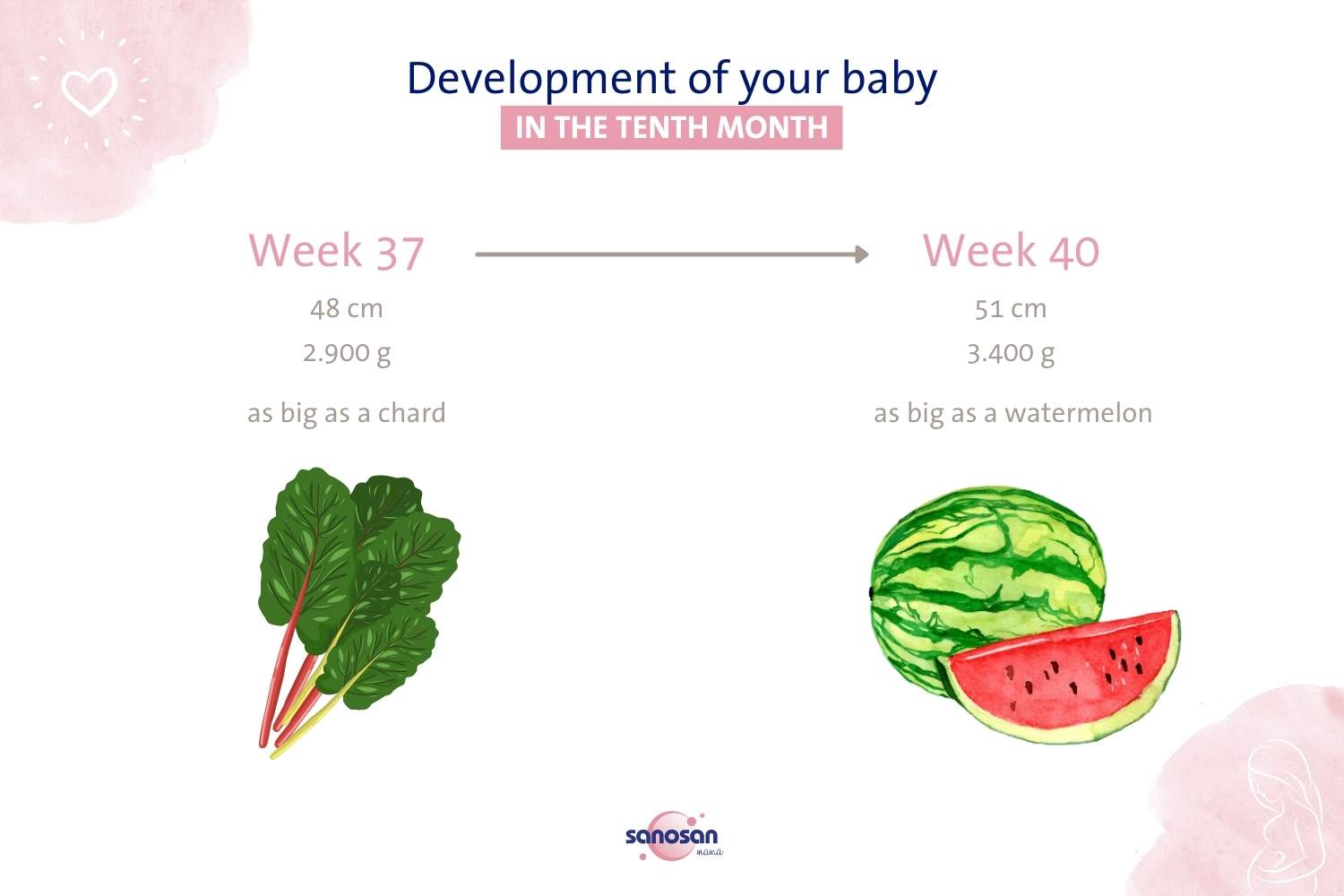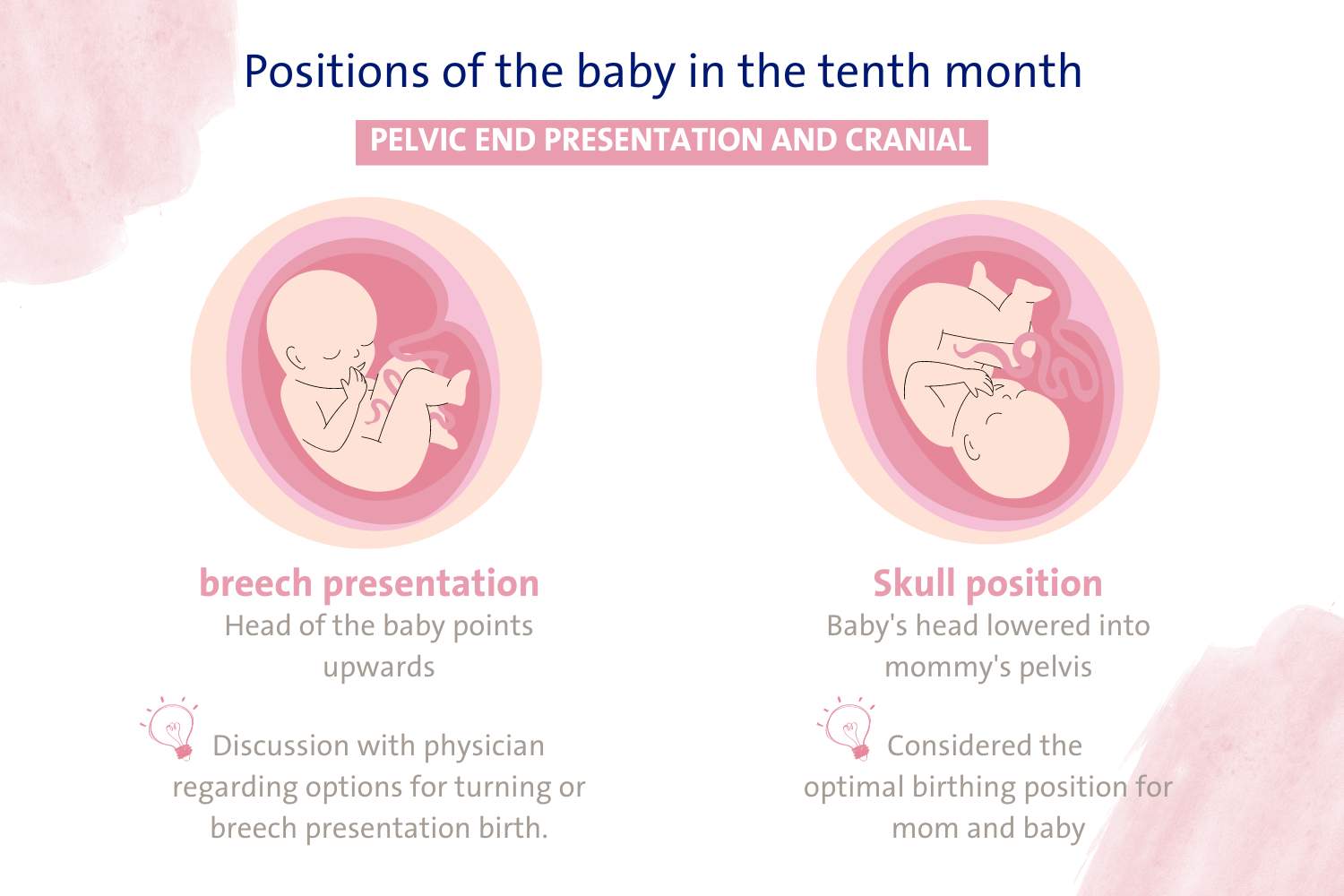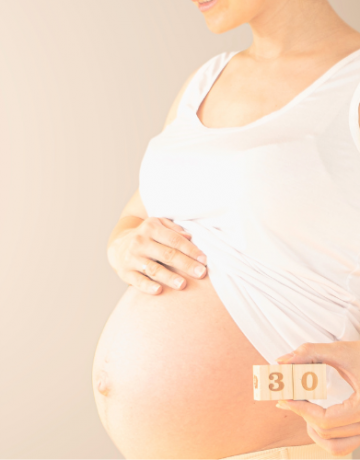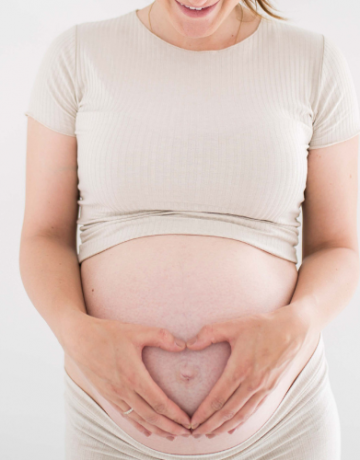The tenth month of pregnancy – Hello little miracle!
Now it’s time to recharge your batteries, enjoy the peace and quiet and once again consciously experience the last few days of togetherness. You have now reached the last weeks of your pregnancy and are officially in your tenth month of pregnancy. Contrary to the common everyday statement that women are nine months pregnant, it is actually 40 weeks of pregnancy and thus ten months. How does your baby develop in the last stages of pregnancy, what happens to your body and what should you think about now? You can find out all this in this article.
How is your baby developing in the tenth month of pregnancy?

If you have reached the 37th week of pregnancy, the baby is almost fully developed and ready for life outside the protective belly. In the last few weeks, it will gain only a few centimeters in size, but will gain more weight. The baby grows about three to four centimeters in the tenth month of pregnancy to an approximate size of 51 centimeters. In addition, the baby gains about another 500 grams in weight, so that it weighs about 3400 grams in the 40th week of pregnancy. During this time, the baby gains mainly in fat reserves. These make up about 15% of the body weight at birth and are important for the newborn to be able to maintain and regulate its body temperature later. The lungs are also fully mature and preparing for the first breath.
Shortly before birth, the baby has less and less space in the abdomen and therefore cannot move as freely. In the tenth month of pregnancy, the baby’s movements and activities may therefore decrease. Most babies sleep a lot during this time and gather strength for the birth. If your baby moves less in the last weeks of pregnancy, this is no reason to worry at first, but is usually completely normal.
Position of the baby in the tenth month of pregnancy – breech presentation or cranial position?

In the best case, the child is now in the cranial position. This means that the baby’s head is pointing downward and has lowered into the expectant mother’s pelvis. The cranial position is considered the optimal birth position for the baby. If this is not yet the case and the baby is still in the breech presentation (head up) in the tenth month of pregnancy, the optimal time for turning is in the 38th week of pregnancy.
External turn for the breech presentation
There is, for example, the possibility of external reversal by your midwife. In most cases, the external reversal is performed as an outpatient procedure in the hospital. Before the external turn is performed, a doctor checks the prerequisites for this: the exact position and size of the baby, the amount of amniotic fluid and the position of the placenta.

IMPORTANT: During the external delivery, the baby’s heartbeat and the mother’s contractions are constantly monitored to make sure that the mother and baby are doing well.
When performing external turning, a health care provider applies pressure to the expectant mom’s lower abdomen in an attempt to lift the baby’s bottom and encourage it to turn. At the same time, the baby’s head is palpated and also guided to turn. In most cases, successful turning takes less than five minutes. Afterwards, the expectant mom is kept in the hospital for observation for about 45 minutes.
Is external turning painful?
During external turning, a certain amount of force must be exerted on the mommy-to-be’s lower abdomen in order to turn the baby. This can cause an uncomfortable to painful feeling of pressure. However, you do not have to be afraid of the external turning. For one thing, a team of doctors is available the whole time to monitor you and your baby. And secondly, you can stop the external turn at any time if it becomes too much or too painful for you.

TIP: Turning is not absolutely necessary. A cesarean section or, in some cases, a breech presentation are also possible. You can discuss what is best for you and your baby individually with your midwife or your gynecologist.
What is there to consider as an expectant mother in the tenth month of pregnancy?
The anticipation of your child increases with each passing day, and for some of you perhaps also the anticipation of the end of pregnancy? Whether you loved being pregnant or you are looking forward to having your body all to yourself again – both are perfectly normal. Most women give birth between 38 and 40 weeks gestation – in fact, only four percent of babies are born on their due date. In the tenth month of pregnancy, the time can come at any time. You can recognize that your body is preparing more and more for the birth by some signs.
Pre-milk or colostrum – what is it?
In the last few days before the birth, you may feel a tightness in your breasts or notice a few drops of colostrum coming out. Pre-milk is also called colostrum. It is very rich in nutrients and protein and is produced in the days before and shortly after birth. The colostrum is somewhat thicker and usually has a yellowish color. You don’t have to worry if colostrum is already coming out during pregnancy – this is how you know that your body is preparing for breastfeeding.
Mucus plug and bloody show – what to watch out for?
You will already be familiar with preterm labor and contractions from the ninth month of pregnancy. And the odd twinge in your back or abdomen is nothing new either. But what are the first signs that your body is preparing for birth?
When your baby is ready to see the light of day, your body sends signals in the form of hormones, such as prostaglandins. These hormones ensure, among other things, that the mucus plug loosens. An indication that the mucus plug is loosening before birth is, for example, increased discharge and discharged mucus, which may also be streaked with a little blood. The color of the mucus plug may be whitish to brownish or even bloody.

IMPORTANT: Do not worry if you do not notice the discharge of the mucus plug. In some women, the amount is very small or occurs only as increased discharge and mucus without blood. This is also completely normal.
The mucus plug is a particularly tough mucus that prevents bacteria from entering the uterus. It has closed the cervix throughout the pregnancy. The discharge of the mucus plug can also be noticeable as slight bleeding. This bleeding is also called bloody show.

IMPORTANT: If you experience prolonged or heavy bleeding that may even be painful, you should contact your gynecologist. In general, if you have a queasy feeling or uncertainty spreads, do not hesitate to ask!
The rupture of the membranes – here we go!
A clear sign that the birth is imminent is the rupture of the membranes, i.e. when the amniotic sac breaks. The amniotic sac surrounds the baby throughout the pregnancy and grows with it. Like the mucus plug, it protects the baby from infection and bacteria.
The rupture of the amniotic sac may be noticeable by a gush of amniotic fluid – but it doesn’t have to be. The fluid can also come out in droplets. In either case, however, the amniotic fluid cannot be contained when the water breaks.
If the water breaks, this is a clear indication that the birth is being induced, but it is no reason to be nervous. The rupture of the membranes does not mean that you have to go straight to the clinic. As long as you feel well and there are no regular contractions, you can stay at home. You can find more information about when you have to go to the clinic or other questions about the birth in this article.
What else should you think about in the tenth month of pregnancy?
In the tenth month of pregnancy, check-ups normally continue to take place every two weeks. The rhythm does not change until the 40th week of pregnancy. From then on, you will probably have a short check-up and examination appointment with your gynecologist every two days.
The most important thing now is to drink plenty of fluids! Due to the increased blood volume and the exertion caused by the additional weight of the baby bump, your body needs a lot of fluids to stay well hydrated.
Finally, there is only one thing left to say: do not stress yourself and be patient! Your body and your baby know when they are ready for birth. Stay positive and look forward to the birth with confidence, because you, your body and your baby can do it! Ten months you have given everything for the development of your baby and very soon you will finally hold your little miracle in your arms.





Comments (0)